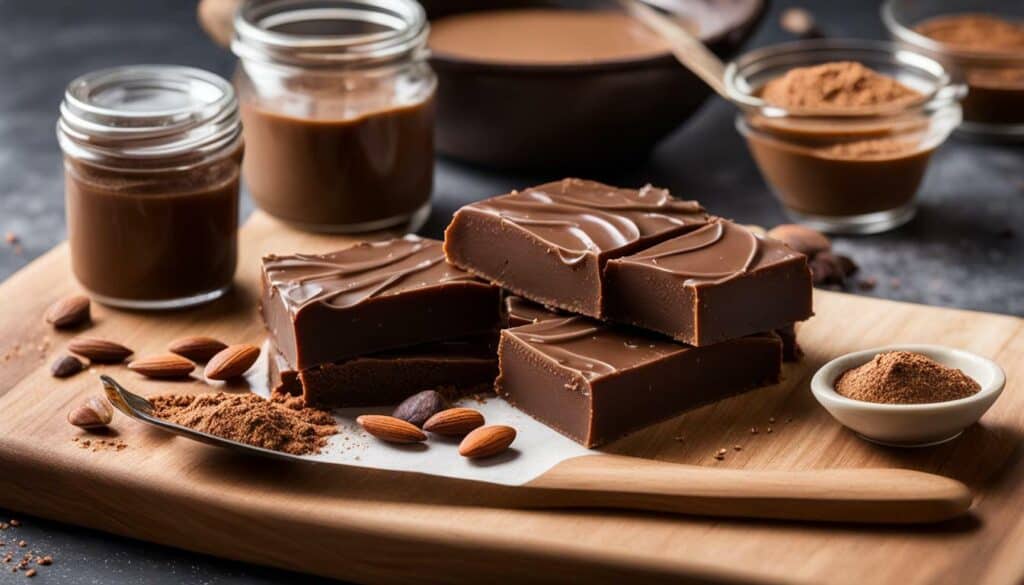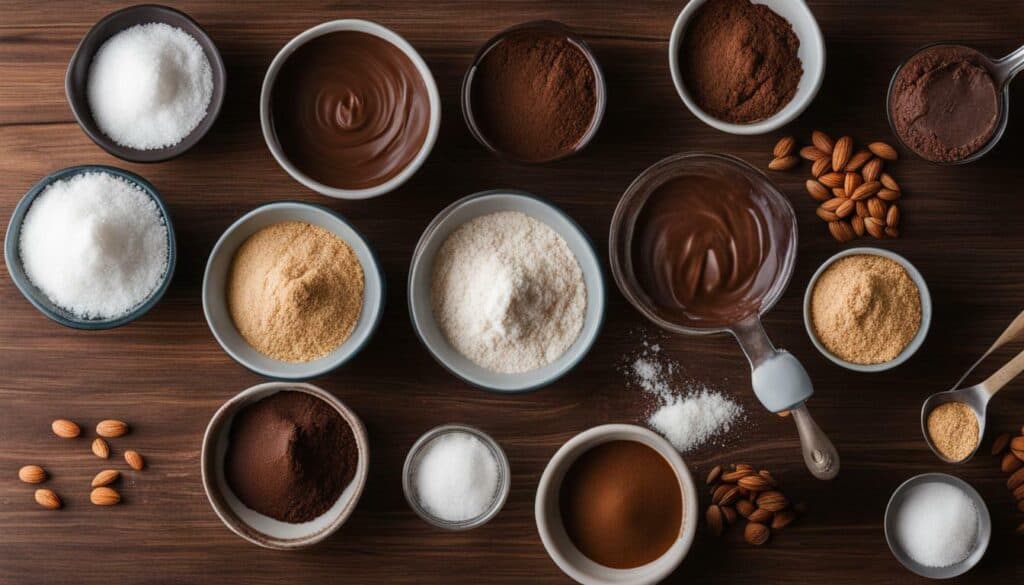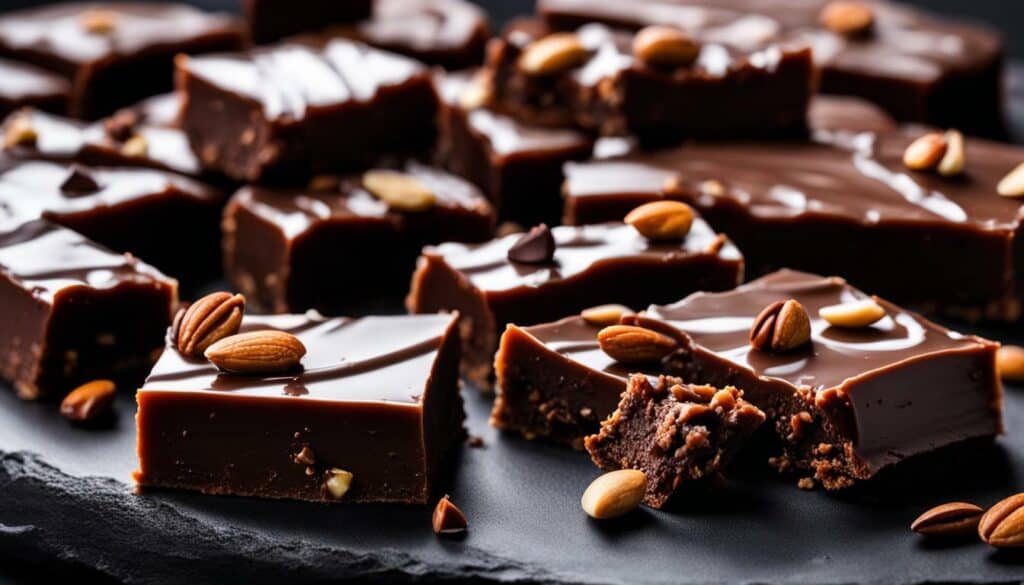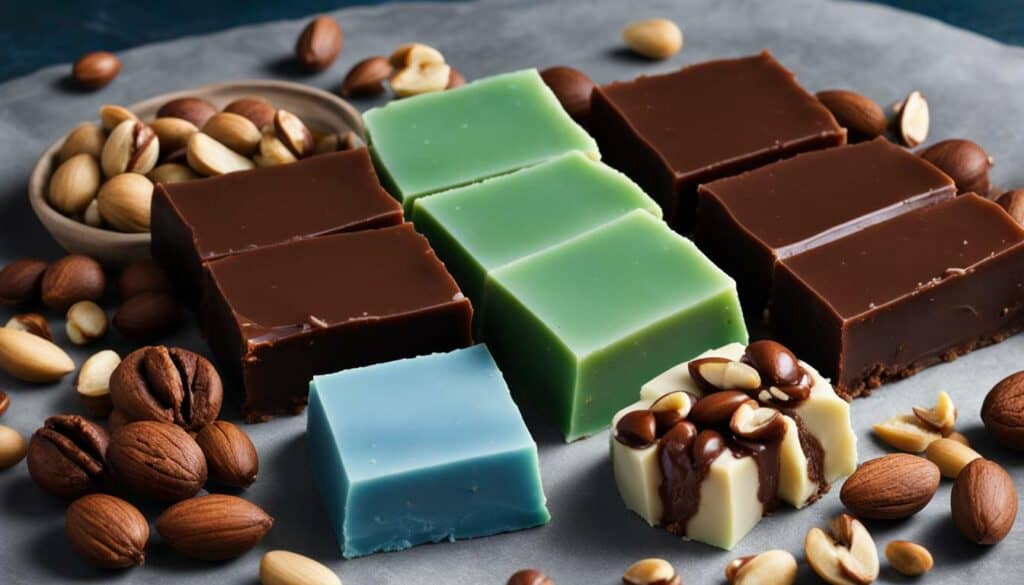Fudge is a beloved sweet treat, but have you ever wondered about its carb content and how it can fit into a low carb diet? Whether you’re watching your carb intake or following a sugar-free lifestyle, understanding the impact of fudge carbs is essential. In this section, we will explore the fascinating world of fudge and delve into its carb content and how it can be enjoyed as part of a low carb diet.
- Fudge can be enjoyed as part of a low carb diet, but it’s important to be mindful of its carb content.
- Low carb fudge recipes and sugar-free fudge options are gaining popularity as people seek healthier alternatives.
- Keto-friendly fudge and low glycemic fudge can be suitable for those following specific diets.
- Understanding the glycemic impact of fudge and exploring fudge alternatives can help make informed choices.
- Portion control and mindful indulgence are key when incorporating fudge into a low carb or ketogenic diet.
Exploring the Carb Content of Fudge
Understanding the carb content of fudge is crucial for those following a low carb or keto diet. While fudge is known for its rich and indulgent taste, it can be deceivingly high in carbohydrates. This becomes particularly important for individuals who need to monitor their daily carb intake to maintain ketosis.
Keto-friendly fudge refers to fudge recipes that have been modified to significantly reduce the carb content. These recipes often replace high-carb ingredients like sugar and flour with low-carb alternatives such as erythritol or almond flour. By making these substitutions, it’s possible to enjoy the sweet delight of fudge while staying within the limits of a low carb or keto diet.
Another consideration for those following a low carb or keto diet is the glycemic index of fudge. The glycemic index measures how quickly a particular food raises blood sugar levels. Low glycemic fudge, which has a lower impact on blood sugar, is often preferred by individuals looking for healthier options. Choosing fudge with a low glycemic index can help maintain stable blood sugar levels and support overall health.
| Fudge Type | Net Carbs per Serving | Glycemic Index |
|---|---|---|
| Traditional Fudge | 20g | High |
| Keto-Friendly Fudge | 4g | Low |
| Low Glycemic Fudge | 6g | Low |
In conclusion, understanding the carb content of fudge is essential for those on a low carb or keto diet. By opting for keto-friendly or low glycemic fudge, individuals can enjoy this sweet treat without compromising their dietary goals. However, it’s important to practice moderation and portion control when incorporating fudge into a low carb or keto lifestyle. Remember to savor the sweetness responsibly.
Quote:
“Choosing fudge with a low glycemic index can help maintain stable blood sugar levels and support overall health.”
The Quest for Healthy Fudge Options
If you’re looking for a guilt-free indulgence, there are several healthy fudge options available. These alternatives offer lower sugar content and are made with healthier ingredients, making them a better choice for those who want to satisfy their sweet tooth without compromising their dietary goals. Whether you’re following a low carb diet, seeking keto-friendly options, or simply looking for lower glycemic alternatives, there are plenty of delicious and nutritious fudge options to explore.
One popular choice is to opt for sugar-free fudge. These fudge varieties are made with sugar substitutes like stevia, erythritol, or monk fruit, reducing the overall sugar content without sacrificing taste. Sugar-free fudge can be a great option for individuals who need to monitor their blood sugar levels or those who are cutting back on their sugar intake. They offer a sweet and satisfying treat without the negative effects of added sugars.
Another healthy fudge alternative is to choose recipes that incorporate more nutritious ingredients. For example, you can make fudge using nut butters like almond or cashew butter instead of traditional dairy butter. These nut butters add healthy fats and protein to the fudge, making it more filling and nutritious. You can also add in other ingredients like dark chocolate, which is rich in antioxidants, or nuts and seeds for added texture and nutrients.
Incorporating fudge alternatives into your diet doesn’t mean you have to compromise on taste. With the right combination of ingredients and flavors, you can create a guilt-free fudge that satisfies your cravings while still supporting your health goals. So, whether you’re following a specific diet plan or simply looking for healthier options, exploring the world of healthy fudge alternatives is a great way to enjoy a delicious treat without any guilt.

| Healthy Fudge Ingredient | Benefits |
|---|---|
| Nut Butters (Almond, Cashew) | Rich in healthy fats and protein, provides a creamy texture |
| Dark Chocolate | High in antioxidants, may improve heart health |
| Nuts and Seeds | Provide added texture and nutrients like vitamins, minerals, and healthy fats |
| Sugar Substitutes (Stevia, Erythritol, Monk Fruit) | Lower in calories and carbohydrates compared to regular sugar |
Crafting a Low Carb Fudge Recipe
Making your own low carb fudge at home is easier than you might think. With a few simple substitutions, you can enjoy this sweet treat without the guilt of traditional high-carb recipes. Whether you’re following a low carb or sugar-free diet, this homemade fudge recipe is perfect for satisfying your cravings.
To start, gather your ingredients. You’ll need unsweetened chocolate, coconut oil, a low carb sweetener like erythritol or stevia, vanilla extract, and any additional flavorings or toppings of your choice. Feel free to get creative and experiment with different flavors like peanut butter or mint.
Next, melt the unsweetened chocolate and coconut oil together over low heat until smooth. Remove from heat and stir in your chosen sweetener, vanilla extract, and any other flavorings. Mix well until all ingredients are fully incorporated.
Once your fudge mixture is ready, pour it into a parchment-lined dish or silicone mold. Smooth the top with a spatula or the back of a spoon. At this point, you can also add any toppings or swirl in additional flavors if desired. Place the dish or mold in the freezer for about an hour until the fudge is firm.
Once the fudge has hardened, remove it from the freezer and let it sit at room temperature for a few minutes to soften slightly. Cut it into small squares or bars and serve. The fudge can be stored in an airtight container in the refrigerator for up to two weeks, making it a convenient and delicious low carb treat to enjoy anytime.
Low Carb Fudge Recipe:
| Ingredients | Instructions |
|---|---|
| 4 oz unsweetened chocolate | In a saucepan, melt the unsweetened chocolate and coconut oil over low heat until smooth. |
| 1/2 cup coconut oil | Remove from heat and stir in low carb sweetener, vanilla extract, and any additional flavorings. |
| 1/4 cup low carb sweetener | Pour the mixture into a parchment-lined dish or silicone mold. Smooth the top. |
| 1 tsp vanilla extract | Add any desired toppings or additional flavors. Freeze for about an hour until firm. |
| Optional: additional flavorings or toppings | Remove from the freezer and let sit at room temperature for a few minutes to soften. Cut into squares or bars. Store in the refrigerator. |
Now you can enjoy your homemade low carb fudge guilt-free, knowing that it fits perfectly into your low carb or sugar-free lifestyle. Get creative with your flavors and share your delicious creations with friends and family. Indulge in a sweet treat without compromising your health goals.

Sugar-free fudge offers a delectable way to enjoy a sweet treat without the guilt and negative health effects of added sugars. Whether you are following a low carb diet, watching your sugar intake, or simply looking for healthier alternatives to traditional fudge, sugar-free options can satisfy your cravings while still keeping you on track with your dietary goals.
One of the main benefits of sugar-free fudge is its lower carbohydrate content. By using alternative sweeteners like stevia or erythritol, sugar-free fudge recipes can significantly reduce the number of carbs compared to traditional fudge. This makes it a suitable option for those who are watching their carb intake, such as individuals following a low carb or ketogenic diet.
Besides being low in carbs, sugar-free fudge also tends to have a lower glycemic index. The glycemic index measures how quickly a food raises blood sugar levels. By using sweeteners that have a minimal impact on blood sugar, sugar-free fudge can be a suitable choice for individuals with blood sugar concerns or those aiming to maintain stable blood sugar levels.
With a myriad of flavors and variations available, sugar-free fudge provides a wide range of options for those looking to indulge their sweet tooth in a healthier way. From classic chocolate to exotic flavors like salted caramel or raspberry swirl, there is a sugar-free fudge recipe for every taste. So go ahead, satisfy your cravings without compromising your health!

| Nutrient | Ginger Snaps (per 100g) |
|---|---|
| Net Carbs | 75.13g |
| Dietary Fiber | 2.2g |
| Fats | 23.57g |
| Protein | 7.28g |
| Sodium | 365mg |
| Potassium | 256mg |
| Iron | 5.63mg |
| B-Vitamins | Varying amounts |
Incorporating Fudge into a Low Carb Diet.
If you’re following a low carb diet, you can still enjoy fudge in moderation with some careful planning. While traditional fudge recipes are typically high in carbs due to the use of sugar and other high carb ingredients, there are ways to create a delicious low carb fudge recipe that satisfies your sweet tooth without derailing your diet goals. By substituting high carb ingredients with healthier alternatives, you can still indulge in a tasty treat that aligns with your low carb lifestyle.
One key ingredient to watch out for when creating a low carb fudge recipe is sugar. Traditional fudge recipes often call for a significant amount of sugar, which can quickly add up in terms of carb content. However, there are various sugar-free sweeteners available that can provide the same level of sweetness without the carb load. Stevia, erythritol, and monk fruit extract are popular options that have a minimal impact on blood sugar levels. Incorporating these sweeteners into your low carb fudge recipe can help reduce the overall carb count while still delivering a delectable taste.
Another way to cut down on the carb content of your fudge is to use alternative flours or nut butters instead of traditional wheat flour. Almond flour, coconut flour, and peanut butter can be excellent substitutes for achieving a desirable texture and flavor. These substitutes are lower in carbs and higher in healthy fats, making them suitable for a low carb lifestyle.
| Ingredient | Carb Content (per 100g) |
|---|---|
| Sugar | 100g |
| Stevia | 0g |
| Erythritol | 5g |
| Monk Fruit Extract | 0.6g |
| Wheat Flour | 76g |
| Almond Flour | 10g |
| Coconut Flour | 57g |
| Peanut Butter | 15g |
Remember, portion control is essential when incorporating fudge into a low carb diet. Although your low carb fudge recipe may have reduced carb content, it’s crucial to enjoy it in moderation to stay within your daily carb limit. By savoring a small portion of your homemade low carb fudge as a treat, you can satisfy your cravings without compromising your dietary goals.

So, whether you’re on a ketogenic diet or simply following a low carb lifestyle, there’s no need to give up on the indulgent pleasure of fudge. With a bit of creativity and smart ingredient choices, you can enjoy a delicious low carb fudge that fits seamlessly into your diet plan. So go ahead and whip up a batch of your favorite low carb fudge recipe, and indulge guilt-free!
Keto-Friendly Fudge: A Delightful Option
For those on a keto diet, there are fudge options available that won’t kick you out of ketosis. These delicious treats are specifically crafted with low carb and low glycemic ingredients, making them a satisfying indulgence without sacrificing your dietary goals. With their rich flavors and creamy textures, keto-friendly fudge options provide a guilt-free way to satisfy your sweet tooth.
One popular keto-friendly fudge option is the decadent chocolate fudge made with a combination of cocoa powder, coconut oil, and a natural low carb sweetener like stevia or erythritol. This fudge offers a rich chocolatey taste while keeping the net carb count to a minimum. It’s a perfect choice for those craving a sweet treat while following a keto lifestyle.
Another mouthwatering option is the creamy vanilla fudge, which can be made using ingredients like heavy cream, butter, and a keto-approved sweetener. This vanilla fudge is not only low in carbs but also high in healthy fats, which can help keep you satiated and in ketosis. With its smooth and velvety texture, it’s a delightful treat that won’t derail your keto progress.

| Fudge Flavor | Net Carbs per Serving (1 piece) | Calories per Serving (1 piece) |
|---|---|---|
| Chocolate | 2g | 80 |
| Vanilla | 1.5g | 75 |
| Strawberry | 2.5g | 85 |
As you can see in the table above, these keto-friendly fudges are not only low in carbs but also low in calories, making them a guilt-free indulgence. Incorporating these fudges into your keto lifestyle is easy. Simply enjoy them in moderation and ensure they fit within your daily carb limit.
With keto-friendly fudge options, you can satisfy your cravings and stay on track with your ketogenic diet. So go ahead and indulge in these delightful treats without the worry of disrupting your ketosis. Remember, enjoy them in moderation and savor every bite!
Understanding the Glycemic Impact of Fudge
If you’re watching your blood sugar levels, low glycemic fudge may be a suitable option for you. Unlike traditional fudge that is laden with sugar and high glycemic carbohydrates, low glycemic fudge is made with ingredients that have a lower impact on blood sugar. This type of fudge can be enjoyed without the guilt and worry of spiking your blood sugar levels.
Low glycemic fudge typically contains alternative sweeteners, such as stevia or monk fruit, which have minimal impact on blood sugar. These sweeteners provide the desired sweetness without the rapid rise in glucose levels. Additionally, low glycemic fudge often incorporates ingredients that are high in fiber, healthy fats, and protein, which can help slow down the release of sugar into the bloodstream.
One option for low glycemic fudge is using dark chocolate that has a higher percentage of cocoa. Dark chocolate with at least 70% cocoa content has a lower glycemic index compared to milk chocolate, making it a better choice for those concerned about blood sugar levels. Adding nuts, such as almonds or walnuts, can also contribute to the lower glycemic impact of fudge due to their fiber and healthy fat content.

Table: Nutritional Comparison of Traditional Fudge and Low Glycemic Fudge
| Nutrient | Traditional Fudge | Low Glycemic Fudge |
|---|---|---|
| Sugar | High | Low or Sugar-Free |
| Glycemic Index | High | Low |
| Fiber | Low | High |
| Healthy Fats | Low | High |
| Protein | Low | Moderate to High |
As you can see from the table above, low glycemic fudge offers a healthier alternative to traditional fudge. With reduced sugar, lower glycemic index, and higher fiber content, it can be a guilt-free indulgence for those mindful of their blood sugar levels. Remember, moderation is key when enjoying any type of fudge, even the low glycemic variety.
Exploring Fudge Alternatives and Substitutes
If you’re looking to switch things up, there are fudge alternatives and substitutes that offer a twist on the classic treat. These options provide a delicious and satisfying experience, while also catering to specific dietary needs and preferences. Whether you’re following a low sugar diet or looking for a healthier alternative, there’s a fudge option out there for you.
One popular fudge alternative is using nut butter as a base. Nut butter, such as almond or cashew butter, can provide a creamy texture and rich flavor that rivals traditional fudge. It’s also a great source of healthy fats and protein, making it a nutritious option. You can customize your nut butter fudge by adding in ingredients like cocoa powder, vanilla extract, or even chopped nuts for extra crunch.
Another option for low sugar fudge is using natural sweeteners like stevia or monk fruit. These sweeteners have minimal impact on blood sugar levels and can be used in place of traditional sugar. You can find stevia or monk fruit sweetened fudge recipes online or experiment with substituting these sweeteners in your favorite fudge recipe. Just be mindful of the conversion ratios as they can vary.
| Fudge Alternatives | Benefits |
|---|---|
| Nut butter fudge | Rich flavor, creamy texture, high in healthy fats and protein |
| Fudge sweetened with stevia or monk fruit | Low impact on blood sugar levels, suitable for low sugar diets |
If you’re looking to indulge in a guilt-free fudge experience, these alternatives and substitutes provide a satisfying solution. They allow you to enjoy the flavors and textures of fudge while supporting your dietary goals.
Fudge Substitutes for Special Dietary Needs
For those with dietary restrictions, there are fudge substitutes that cater to specific needs. If you’re following a vegan or dairy-free diet, you can opt for coconut cream or full-fat coconut milk as a base for your fudge. These alternatives provide a rich and creamy texture without the use of dairy products.
- Coconut cream or full-fat coconut milk
- Vegan-friendly, dairy-free option
- Rich and creamy texture
If you’re on a gluten-free diet, you can use gluten-free flours like almond flour or coconut flour as a substitute for traditional flour in your fudge recipe. These flours are also lower in carbohydrates, making them a suitable option for those following a low carb or keto diet.
- Gluten-free flours (almond flour, coconut flour)
- Carb-conscious, suitable for low carb or keto diets
- Gluten-free alternative
With these fudge alternatives and substitutes, you can enjoy a delectable treat that aligns with your dietary needs and preferences. Whether you’re looking to reduce sugar intake, avoid certain ingredients, or simply try something new, these options offer a delicious twist on the classic fudge recipe.

While fudge is often considered a decadent treat, it does contain certain nutrients that are worth considering. When enjoyed in moderation and as part of a balanced diet, fudge can provide a touch of sweetness without compromising your health goals. Let’s take a closer look at the nutritional value of fudge.
Fudge typically contains a combination of sugar, butter, and cream, which contribute to its rich and creamy texture. These ingredients also provide a significant amount of calories and fats. However, it’s important to note that not all fats are created equal. Fudge contains saturated fats, which have been associated with an increased risk of heart disease. While indulging in fudge, it’s crucial to be mindful of portion sizes to avoid excessive intake of these fats.
In addition to fats, fudge can also provide small amounts of protein and dietary fiber. These nutrients are essential for supporting various bodily functions, including muscle growth and digestion. However, it’s important to note that the protein and fiber content in fudge is relatively low compared to other sources, such as lean meats and whole grains.
To give you a clearer picture of the nutritional composition of fudge, here’s a breakdown per 100 grams:
| Nutrient | Amount |
|---|---|
| Calories | 365 |
| Protein | 2 grams |
| Fat | 15 grams |
| Carbohydrates | 56 grams |
| Fiber | 1 gram |
| Sugar | 51 grams |
While fudge may not be a nutritional powerhouse, it can be enjoyed in moderation as a treat. If you’re watching your carbohydrate intake, it’s important to consider fudge alternatives that are lower in sugar or even sugar-free. With mindful indulgence and conscious choices, you can still satisfy your sweet tooth while maintaining a healthy lifestyle.

Remember, the key to a balanced diet is moderation and variety. Adding fudge as an occasional treat can bring joy to your taste buds without derailing your health goals. So go ahead, savor a piece of fudge, but remember to enjoy it in moderation along with a nutritious diet.
Conclusion
Fudge can be enjoyed as part of a balanced diet, and with the right knowledge, you can make informed choices that align with your health goals. Understanding the impact of fudge carbs is essential, especially for those following low carb or keto diets. By exploring the carb content of fudge and seeking out healthier alternatives, you can still indulge in this sweet treat without sacrificing your dietary preferences.
Low carb fudge recipes and sugar-free options offer a way to satisfy your sweet tooth while keeping your carb intake in check. These alternatives often utilize ingredients that are low glycemic, providing a slower release of sugars into the bloodstream and minimizing the impact on blood sugar levels.
When incorporating fudge into a low carb or keto diet, portion control and mindful indulgence are key. By carefully measuring your servings and being aware of your overall carbohydrate intake, you can enjoy fudge without jeopardizing your progress.
While fudge can be a delicious treat, it’s important to remember that moderation is key. By choosing low carb fudge options, exploring fudge alternatives, and considering the nutritional value of fudge, you can enjoy this sweet delicacy while still maintaining a healthy lifestyle.
FAQ
Q: Are Ginger Snaps keto-friendly?
A: No, Ginger Snaps are not keto-friendly due to their high carbohydrate content.
Q: How many carbs do Ginger Snaps have?
A: Ginger Snaps contain 75.13 grams of net carbs per 100 grams.
Q: Can I incorporate Ginger Snaps into a keto diet?
A: It is challenging to incorporate Ginger Snaps into a keto diet, but it can be possible with careful planning and portion control.
Q: What nutrients do Ginger Snaps contain?
A: Ginger Snaps contain dietary fiber, fats, protein, sodium, potassium, iron, and B-vitamins.
Q: Are Ginger Snaps healthy?
A: While Ginger Snaps have health properties from ginger, cinnamon, and cloves, their high carb content outweighs these benefits.
Q: Why is tracking daily carb intake important on a keto diet?
A: Tracking daily carb intake is important for maintaining ketosis, which is the state of burning fat for fuel.
What Are the Carbohydrate Content in Greek Dressing?
The carbs in greek dressing discovered vary depending on the brand and recipe used. Generally, Greek dressings contain a low carbohydrate content due to their main ingredients: olive oil, lemon juice, and various herbs and spices. However, some store-bought versions may have added sugars or thickeners that can increase the carbohydrate count. It is always recommended to check the nutritional label to get accurate information about the carbohydrate content of a specific Greek dressing.





Leave a Reply